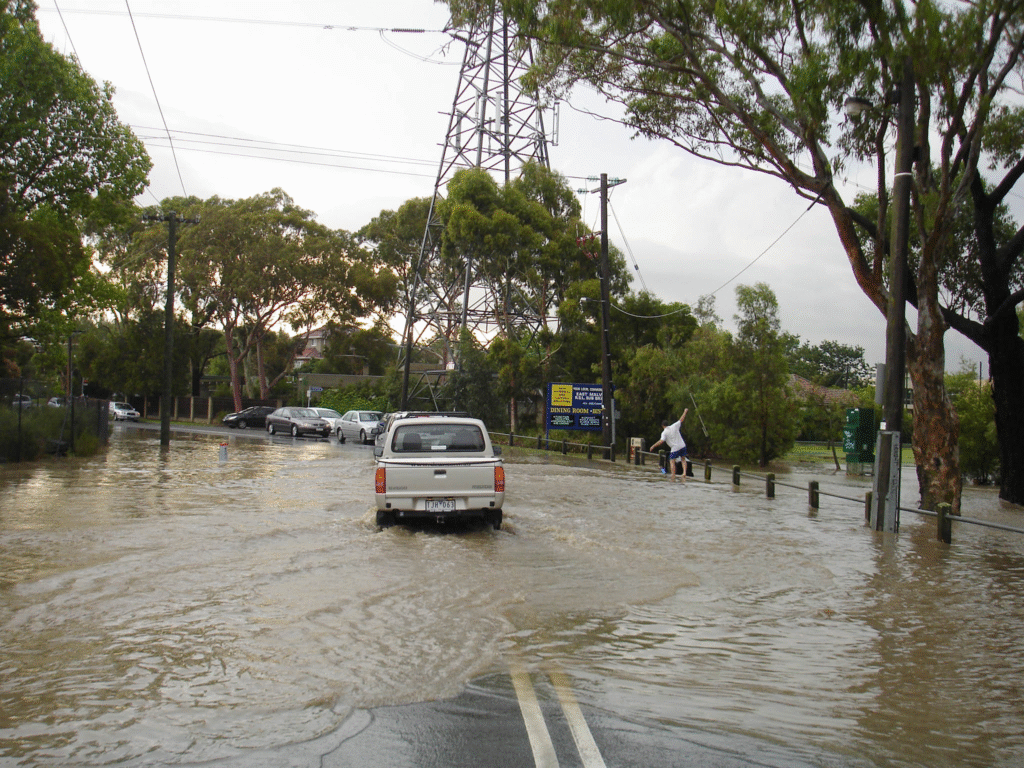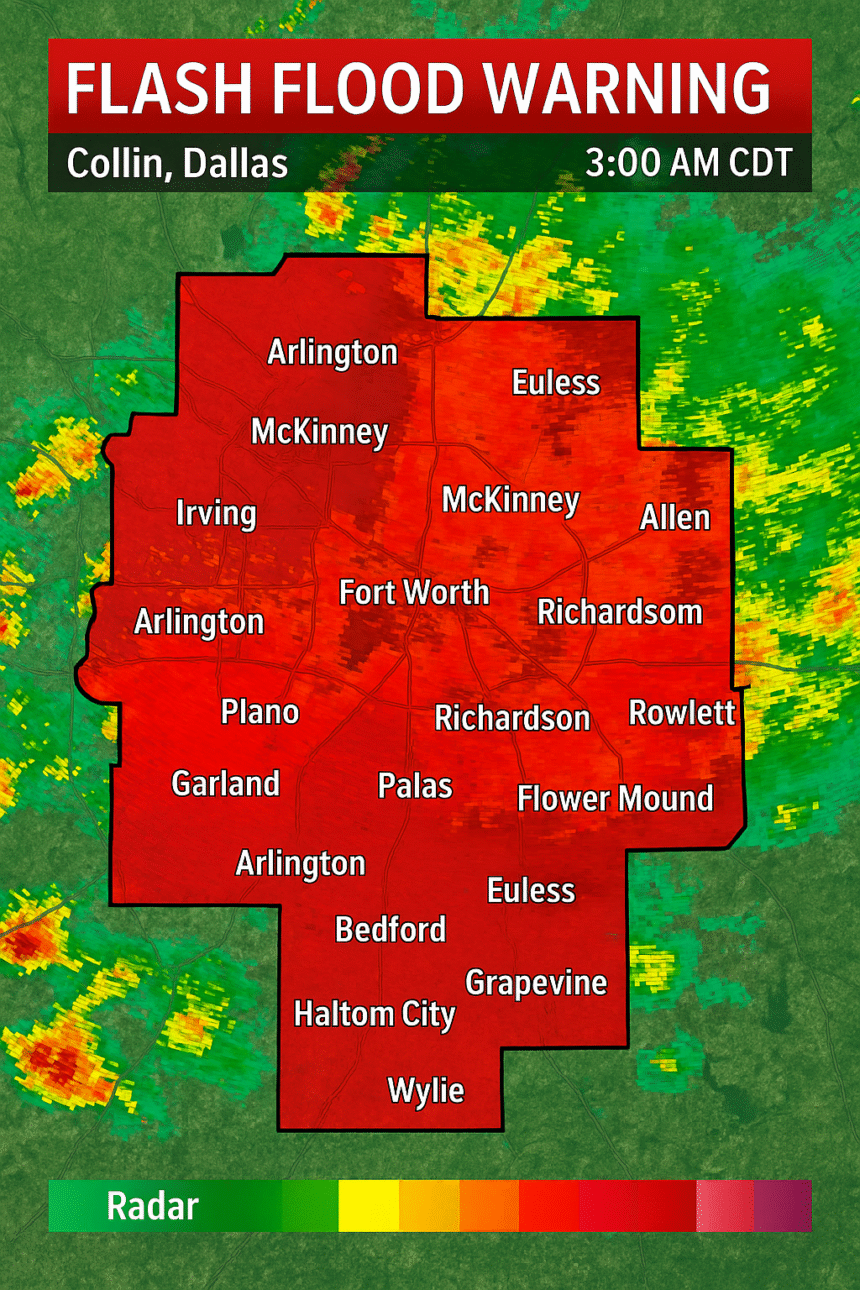🌧️ Flash Floods Threaten North Texas: Immediate Action Advised
The National Weather Service (NWS) Fort Worth TX has issued an urgent flash flood warning for Collin, Dallas, and Tarrant counties, in effect until 6:00 a.m. Monday. Residents in the affected areas—including Dallas, Fort Worth, Arlington, Plano, and Garland—are urged to stay alert, avoid travel, and take immediate safety measures.
As of 2:51 a.m., Doppler radar detected heavy thunderstorms producing 1 to 2 inches of rainfall, with another 1 to 2 inches expected. The situation is rapidly evolving, and flash flooding is either ongoing or imminent.
📍 Location: Collin, Dallas, and Tarrant Counties (North Texas)
🕓 Timeframe: Until Monday, 6:00 a.m
🚨 Areas Under Threat: Cities and Towns on High Alert
The warning impacts some of the most densely populated areas in North Texas, including but not limited to:
- Dallas
- Fort Worth
- Arlington
- Plano
- Garland
- Irving
- Grand Prairie
- McKinney
- Carrollton
- Frisco
- Richardson
- Allen
- Flower Mound
- Mesquite
- Euless, Bedford, Grapevine, Rowlett, Haltom City, and Wylie
These urban zones are particularly vulnerable due to poor drainage systems, highway underpasses, and congested stormwater routes, all of which can become dangerous during a flood.
🔥 Why Flash Flood Warnings Demand Urgency
Flash floods are one of the most dangerous weather-related events, especially at night. As the NWS strongly advises:
“Turn around, don’t drown.”
This isn’t just a slogan—it’s life-saving advice. Over 75% of flood-related fatalities occur when people attempt to drive through flooded roads. Even 12 inches of rapidly moving water can sweep away most vehicles.
🧠 What You Should Do: Safety Guidelines from NWS
If You’re in a Flood-Prone or Low-Lying Area:
- 🚶♂️ Move to higher ground immediately.
- 🏠 Evacuate if instructed and lock up your home securely.
- 🔌 If there’s time, disconnect all utilities and appliances.
- 🚫 Avoid basements or rooms with submerged electrical outlets.
- ⚡ If you see sparks or hear crackling/buzzing, leave the area right away.
- 🌊 Never wade or walk through floodwaters—as little as 6 inches can knock an adult off their feet.
- 📞 Call 911 if you become trapped.
🚗 Driving During a Flash Flood: DOs and DON’Ts

✅ DO:
- 💡 Turn on headlights to improve visibility.
- 🚗 Drive in middle lanes and stay on elevated roads.
- 📏 Maintain a safe distance from large vehicles to avoid splash and visibility loss.
❌ DON’T:
- ❌ Attempt to cross flooded roads, no matter how shallow they appear.
- ❌ Drive into large puddles or standing water.
- ❌ Tailgate buses or trucks—spray can blind your vision.
❓ What is Hydroplaning and Why is It Dangerous?
Hydroplaning occurs when your vehicle slides uncontrollably on a thin layer of water. This happens when water builds up in front of your tires faster than your vehicle can push it aside.
Top 3 Causes of Hydroplaning:
- High speed – Fast-moving vehicles are more likely to lose tire traction.
- Deep water – Even shallow water can lead to sliding.
- Worn tire treads – Bald tires drastically reduce grip.
How to Regain Control if You Hydroplane:
- 🦶 Ease off the accelerator immediately.
- 🔄 Gently turn into the skid to realign your tires.
- 🛞 Wait until the tires reconnect with the road surface.
- 🧯 Brake gently if your car has ABS, or pump the brakes in older vehicles.
❓ Frequently Asked Questions (FAQs)
🌀 Q: What’s the difference between a Flash Flood Watch and a Warning?
A: A watch means conditions are favorable for flash flooding. A warning means it’s already occurring or about to occur.
🚫 Q: Can I drive through 6 inches of water?
A: No. Six inches can knock over an adult and 12 inches can move most vehicles.
🧳 Q: What should I pack in an emergency flood kit?
A: Essentials include water, non-perishable food, flashlight, batteries, first aid, cash, documents, and medications.
🏠 Q: Should I evacuate even if the floodwater isn’t near my home yet?
A: Yes. If authorities instruct evacuation, do so immediately. Flash floods can arrive within minutes.
✅ Final Thoughts: Stay Safe, Stay Informed
Flash floods can escalate in seconds, turning roads into rivers and homes into islands. The key to survival is preparation, awareness, and respecting the power of nature. Stay tuned to official weather updates, follow evacuation orders, and never underestimate flash flooding.
Turn around. Don’t drown.
📢 Share This Alert
Help keep others safe. Share this guide with family, friends, and community groups in North Texas.







